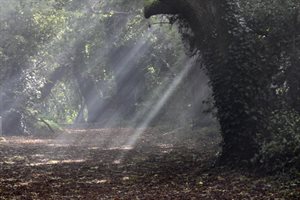C osmeston Lakes Country Park
osmeston Lakes Country Park
Cosmeston has over 20ha of broad-leaved woodland, the main gravel pathway runs through the centre of Cogan wood with many off the beaten tracks for you to discover. The woodland at cosmeston is typical of many broad-leaved types of woodland in the UK, oak, ash, elm, hawthorn and blackthorn making up the majority of the tree species found with dense ivy covering both tree and ground in many places.
On summer evenings at Cosmeston look out for the flittering shapes of hunting bats like the pipistrelle as they swoop through the woodlands and over the lakes in search of tasty midges and other insects. In certain areas of the park, large numbers of these agile mammals can be seen feeding together in the fading light. Management of the woodland at cosmeston consists of opening up and clearing small sections to allow sunlight to enter, this results in ground flora having a chance to germinate and flower.
In 2019 Cosmeston Lakes Country Park was successful in gaining funding from Network Rail through The Greater West Programme; a biodiversity offsetting scheme that supports the delivery of habitat planting and enhancement projects on third party land. The grant funding saw a two-hectare extension to the Southern edge of Cogan Wood. In total 1,350 trees were planted to include a mixed selection of fruit trees. Tree planting has many social, environmental, and health and well-being benefits and provides an added feature to the Country Park.